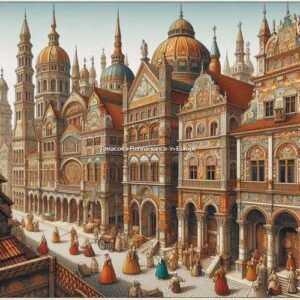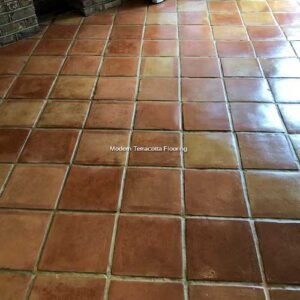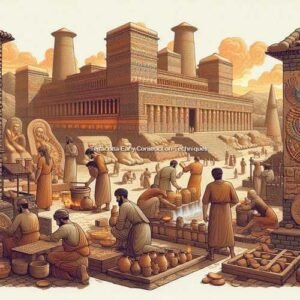Terracotta tiles have a long-standing presence in architecture and design, boasting a fascinating heritage encompassing various cultures and eras. These tiles have proven durable and adapted to changing trends, making them a popular choice for a wide range of uses. In this blog post, we will delve into the intriguing history of Terracotta and explore its widespread applications in modern design.
Ancient Origins: Discovering the Roots of Terracotta Tiles
Origins in Mesopotamia
Terracotta, a material used in construction for centuries, derives its name from the Italian phrase “baked earth.” Its origins can be traced back to the 3rd millennium BC in Mesopotamia, where it was commonly used to construct dwellings and temples. These tiles are perfect for such purposes due to their durability and natural beauty.
In ancient Mesopotamia, Terracotta served a dual purpose—it was not only functional but also carried deep symbolic meaning. The Assyrians and Babylonians extensively used Terracotta to construct palaces and religious sites. Its application served functional and ornamental purposes, highlighting its immense aesthetic and cultural value.
Construction Methods from the Past
The early utilisation of Terracotta in Mesopotamia established the foundation for its lasting impact. Builders in Mesopotamia were well aware of the material's remarkable durability in the face of harsh weather conditions. Creating Terracotta involves shaping clay into desired forms and firing it at high temperatures for a hardened, durable product. This technique has remained virtually the same for millennia.
Evolution in Mediterranean Cultures: The Rise of Terracotta in Greece and Rome
Greece In Antiquity
Terracotta became widely used in the Mediterranean cultures of Greece and Rome, valued for its practicality and pleasing appearance. During ancient times in Greece, Terracotta was a popular material for constructing temples and public buildings. Greek architects excelled in working with Terracotta, creating elaborately shaped tiles arranged in intricate designs.
Advancements in Ancient Rome
The Romans made significant advancements in terracotta tile production techniques. They introduced moulds to ensure uniformity and experimented with various shapes, designs, intricate patterns, and pictorial motifs. Roman builders widely used Terracotta across multiple construction projects, including villas, public baths, and theatres. The development of interlocking roof tiles, known as “tegulae” and “imbrices,” was a remarkable Roman innovation.
Significance in Culture
Terracotta tiles in Roman architecture frequently showcased depictions of mythology and everyday life, reflecting the cultural values and artistic accomplishments of the era. The durability of Terracotta has ensured that many structures have stood the test of time, enabling modern observers to admire the skill of ancient builders.
 Terracotta Renaissance in Europe: Reviving an Ancient Craft
Terracotta Renaissance in Europe: Reviving an Ancient Craft
A New Beginning In The Renaissance
There was a renewed interest in Terracotta during the Renaissance era in Europe. Architects and designers have embraced this versatile material to bring a touch of sophistication to their projects. The tiles beautifully decorated the exteriors of magnificent structures, including grand buildings, churches, and palaces, demonstrating their capacity to elevate visual appeal while offering insulation and safeguarding.
Renowned Renaissance architects, such as Brunelleschi and Michelangelo, skillfully integrated Terracotta into their architectural masterpieces, appreciating its ability to create intricate and captivating exteriors.
Technical and Artistic Advancements
The Renaissance was a time of remarkable technology and art progress. Artisans perfected innovative glazing methods that infused terracotta tiles with rich hues and a lustrous sheen, elevating their allure.
Influence on European Architecture
The extensive use of Terracotta during the Renaissance greatly influenced European architecture, which persisted throughout the Baroque and Rococo eras.
Terracotta in Contemporary Design: Embracing Tradition in Modern Spaces
Modern Applications
Today, Terracotta continues to be popular in contemporary design. Their natural earthy tones and rustic charm lend warmth and character to indoor and outdoor spaces. In modern interior design, terracotta floors create a cosy and inviting atmosphere, often used in kitchens, living rooms, and bathrooms.
Sustainable and Eco-Friendly Choice
Terracotta floors are an eco-friendly option for sustainable building practices. Made from natural clay, they are biodegradable and have a low environmental impact. Their production process requires less energy than other building materials, and their durability means they have a long lifespan, reducing the need for frequent replacements.
Innovative Design Trends
Recent design trends have seen a resurgence in the use of Terracotta, with designers and architects exploring new ways to incorporate this timeless material into their projects. Terracotta tiles easily suit contemporary tastes, from geometric patterns and bold colours to minimalist and industrial aesthetics.
 Common Uses and Applications: Versatile and Functional Terracotta Tiles
Common Uses and Applications: Versatile and Functional Terracotta Tiles
Floor Covering
Terracotta can create captivating feature walls that enhance any room's texture and visual appeal. They are highly effective in spaces that strive for a rustic or Mediterranean-inspired look.
Wall Covering
Terracotta can create stunning feature walls, adding texture and visual interest to any room. They work exceptionally well in spaces aiming for a rustic or Mediterranean-inspired aesthetic.
Roofing Material
Terracotta is a highly durable material, making it excellent for roofing. Terracotta offers exceptional protection from the elements while adding a unique charm to any building.
Stylish Embellishments
Terracotta tiles are famous for decorative accents in various architectural elements, including arches, columns, and cornices. Their adaptability enables designers to craft one-of-a-kind and visually captivating elements.
Landscape And Garden Use
Terracotta tiles are a great choice for enhancing the aesthetic appeal of garden paths, courtyards, and poolside areas. They bring a touch of natural beauty to outdoor spaces, and their earthy tones and textured surfaces effortlessly harmonise with the surrounding natural environment.
FAQs About Terracotta Tiles
What advantages do terracotta tiles offer in sustainable architecture?
Terracotta tiles are crafted with the utmost care, using natural clay, ensuring their eco-friendly nature and minimal environmental impact. With their exceptional durability and impressive lifespan, there is no need for frequent replacements.
What are some ways to improve the colour of terracotta tiles?
Consistent cleaning and effective sealing can help to enhance the colour. Utilising a colour-enhancing sealer can further accentuate the inherent shades.
Are there any current design trends for terracotta tiles?
Indeed, contemporary design incorporates geometric patterns and vibrant colours and seamlessly blends with minimalist and industrial aesthetics.
What are the recommended methods for installing terracotta tiles?
Proper surface preparation, selecting the appropriate adhesive, and allowing ample drying time are crucial for optimal results. Expert installation guarantees a secure and reliable placement.
Is it possible to utilise terracotta tiles for heated flooring systems?
Indeed, terracotta tiles are well-suited for heated flooring systems, ensuring effective heat distribution and a pleasant temperature.
Relevant Hyperlinked Sources
The post: Terracotta Tiles: A Fascinating Journey Through History and Time appeared first on TileCleaningSurrey.co.uk
The Article Terracotta Tiles: An Engaging Exploration of the Past and Present appeared first on https://fabritec.org
The Article Terracotta Tiles: An Engaging Exploration of the Past and Present Was Found On https://limitsofstrategy.com




I’ve always found terracotta fascinating, especially when considering its journey through history. It’s incredible how a simple material can carry so much weight in terms of cultural significance and architectural beauty. I remember visiting a museum exhibit on ancient Mesopotamian artifacts, and the terracotta pottery stood out to me. They weren’t just everyday items; each piece told a story, showcasing the artistry and skill of the people who made them.
It’s interesting to hear how your experience with terracotta artifacts sparked such a deep appreciation for its historical context. You’re spot on about the inherent storytelling in each piece. When you think about it, terracotta isn’t just a utilitarian material; it’s a snapshot of the values, practices, and artistry of its time.
I completely agree with you about the storytelling aspect of terracotta artifacts. Each piece not only holds the physical traces of its creators but also encapsulates the essence of the society it originated from. The way terracotta captures daily life, rituals, and beliefs offers such a rich tapestry to explore.
You’ve captured the essence of terracotta artifacts beautifully. It’s fascinating how these objects serve as a bridge connecting us to the lives and thoughts of people who lived hundreds, sometimes thousands, of years ago. Each piece is like a time capsule, isn’t it? When I see something that might depict a daily activity or a ritual, I can’t help but wonder what those moments felt like for the people involved.
It’s true, each terracotta piece really does carry such a depth of history. I find myself often pondering how these artifacts not only reflect daily activities or rituals but also the values and beliefs of the communities who created them. For instance, there are those intricate figurines that seem to represent fertility and agriculture—a connection to the earth and sustenance that feels so universal even today.
You’ve hit on something really profound with that connection to fertility and agriculture. It’s fascinating how these terracotta pieces act as a bridge between the past and our present lives, isn’t it? Each piece tells a story that extends beyond just its physical form, resonating with the struggles and triumphs of those who came before us.
It’s interesting to think of terracotta artifacts as those time capsules you mentioned. They do hold so much weight in terms of cultural context, don’t they? When I see those pieces, I often wonder about the people who shaped them, their environments, and what daily life looked like for them. There’s something deeply human in these artifacts—it’s a connection that goes beyond mere aesthetics; it’s about understanding their hopes, struggles, and joys.
It’s captivating to think about how terracotta artifacts can tell us so much about the human experience. Each piece not only reflects a specific moment in time but also the emotions, beliefs, and daily routines of its makers. When we look at something that might depict a daily activity or ritual, we’re really piecing together a snapshot of lives that were once filled with laughter, struggles, and connections just like our own.
I totally get what you mean about terracotta. It’s remarkable how something so seemingly simple can hold so much depth and history. I remember visiting a similar exhibit and being struck by the intricate details on the pots and how they reflected the lives of the people who crafted them. It’s almost like each piece encapsulates a moment in time, a glimpse into the everyday yet significant lives of those ancient cultures.
It’s so interesting to hear how your experience with terracotta pottery in that museum has stuck with you. That’s the thing about this material—it carries so much history, and it’s like each vessel whispers its own story through the ages. Ancient Mesopotamia, with its rich tapestry of cultures and innovations, really gives you a sense of how critical terracotta was, not only for daily living but also as a canvas for creative expression.
I completely understand your fascination with terracotta—it’s remarkable how it connects us to different cultures and eras. Those ancient Mesopotamian pieces really are like portals to the past, aren’t they? I remember seeing similar artifacts during a visit to an archaeological site; it really struck me how something so ordinary in its raw materials could be imbued with such depth and significance.
Your reflection on terracotta resonates deeply with me, especially when it comes to how these artifacts act as windows into worlds long past. Terracotta, often seen as humble material, tells such profound stories about the people who crafted them. In ancient Mesopotamia, for instance, every piece was not just a tool or decoration; it carried the fingerprints of its maker, who likely had their hopes and aspirations intertwined with their art.
I’m glad you share that fascination with terracotta! It’s fascinating how these seemingly simple materials can carry the weight of history, isn’t it? When I think about those ancient Mesopotamian artifacts, I’m struck by their utility and artistry. They weren’t just decorative pieces; they served everyday purposes and were often part of rituals or trade. It’s remarkable how they encapsulate the lives of people from thousands of years ago, offering glimpses into their daily routines, beliefs, and even their aspirations.
I’ve always found the history of materials like terracotta to be so fascinating, especially since they often tell us a lot about the cultures that used them. It’s impressive to think that terracotta tiles have been around since the 3rd millennium BC! The idea that something so seemingly simple had such deep roots, both literally and symbolically, makes it even more appealing.
It’s fascinating to see how terracotta tiles have maintained their relevance throughout history, evolving alongside different cultures. The duality of their function—both as practical building material and as a cultural symbol—really highlights how art and utility often intersect in design. It makes me think about the ways modern architects are reviving traditional materials like terracotta in sustainable design projects today. Have you noticed how contemporary interpretations often embrace the natural imperfections of terracotta, adding character to spaces? I’m curious—what do you think draws designers back to terracotta in a world filled with high-tech alternatives?
You’ve touched on something really profound with the way terracotta tiles straddle the line between utility and artistry. There’s a certain warmth in their earthy tones that often evokes a tactile connection to the spaces we inhabit; it’s as if they carry stories from the past while remaining deeply relevant today.
You’ve really captured the essence of terracotta tiles. It’s fascinating how these simple, unassuming materials can convey so much depth—an interplay that often goes unnoticed in our fast-paced lives. When we walk over these warm tiles, it’s almost like we’re stepping into a little piece of history. You mentioned the earthy tones, and it’s interesting how these colors can evoke a sense of grounding and connection, as if they’re whispering stories of the landscape they originated from.
You raise some excellent points about the relevance of terracotta tiles—it’s interesting how they blur the line between art and functionality. In a world leaning heavily on sleek, high-tech materials, it’s the warmth and authenticity of terracotta that draws designers back. Its variability allows for unique expressions, which can feel more connected to nature and the local environment compared to synthetic options.
It’s fascinating to think about how a material like terracotta has such deep historical roots, yet continues to feel relevant in modern design. I’ve always loved the warmth and texture of terracotta tiles; they bring a natural, earthy vibe, which I think is increasingly important in our often sterile, tech-heavy environments.
You’ve really captured something special about terracotta. It’s amazing how a material that has been around for thousands of years can feel so contemporary today. When you mention its warmth and texture, it hits home what many of us look for in our spaces. In a world often filled with sleek surfaces and sterile environments, there’s a real comfort found in the imperfections and earthy tones of terracotta.